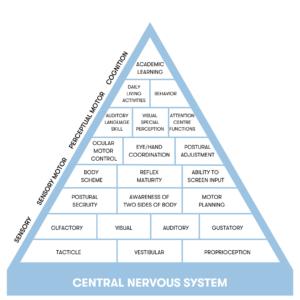‘All about Sensory Processing’ was the theme of MeBe Learning’s March webinar, where MeBe Occupational Therapists introduced sensory processing as a concept and further defined how each of our senses processes external inputs. As April is Occupational Therapy month, what better time than now to kick-off a blog series on pediatric sensory processing!
What is Sensory Processing?
Sensory processing is the way the nervous system receives messages from the senses and turns them into appropriate motor and behavioral responses. Processing sensory is an automatic response that happens to all of us. Everyone has sensory sensitivities, but when those sensitivities start interrupting your everyday, it raises cause for concern. Some individuals might struggle with processing sensory information, which is otherwise known as Sensory Processing Disorder.
The 8 Senses
There are eight different senses that gather sensory input. These senses make the framework for higher level processing and form the foundation for childhood development. (See below: Williams and Shellenberger 1996, Pyramid of Learning) These include…
- Vision
- Tactile (touch)
- Auditory (hearing)
- Gustatory (taste)
- Olfaction (smell)
- Proprioception (body position)
- Vestibular (head position)
- Interoception (internal)

(Williams and Shellenberger, 1996)
How is Sensory Processed?
There are two major categories of processing sensory information, under-responsive and over-responsive. Being under-responsive to sensory input means that an individual might not perceive that sense or sensation at the same level that other people might. On the other hand, being over-responsive to sensory input means that a sense or sensation is felt too much.
- Sensory Seeking
- under-responsive
- Sensory Avoiding
- over-responsive
- Sensory Sensitivity
- over-responsive
- Sensory Registration
- under-responsive
Sensory Processing Concerns
Being over or under responsive to sensory input can also be referred to as Sensory Modulation Disorder. Generally speaking, kids with sensory modulation issues have trouble regulating and responding to sensory input.
Other sensory processing concerns include:
- Sensory Discrimination and Perceptual Problem
- Vestibular Bilateral Functional Problems
- Praxis Problems
As this series of blog articles continues, we will further discuss each of the eight senses and what being over or under-responsive in each category looks like, as well as strategies you can practice at home with your child. Stay tuned for more!
Explore the senses:
Tactile Sensory Processing
Visual Sensory Processing
Auditory Sensory Processing
Gustatory Sensory Processing
Olfactory Sensory Processing
Proprioceptive Sensory Processing
Vestibular Sensory Processing
Interoceptive Sensory Processing
MeBe Occupational Therapy Services
To learn more about Sensory Processing, watch the recorded MeBe Learning Webinar, All About Sensory Processing.
If you’re ready to learn more about Occupational Therapy, Applied Behavior Analysis, Speech and Language Pathology or Feeding Therapy services at MeBe, contact us today.
For helpful tips from the MeBe therapy team, check out @mebefamily on Instagram and Facebook and visit the MeBe Family YouTube channel.

